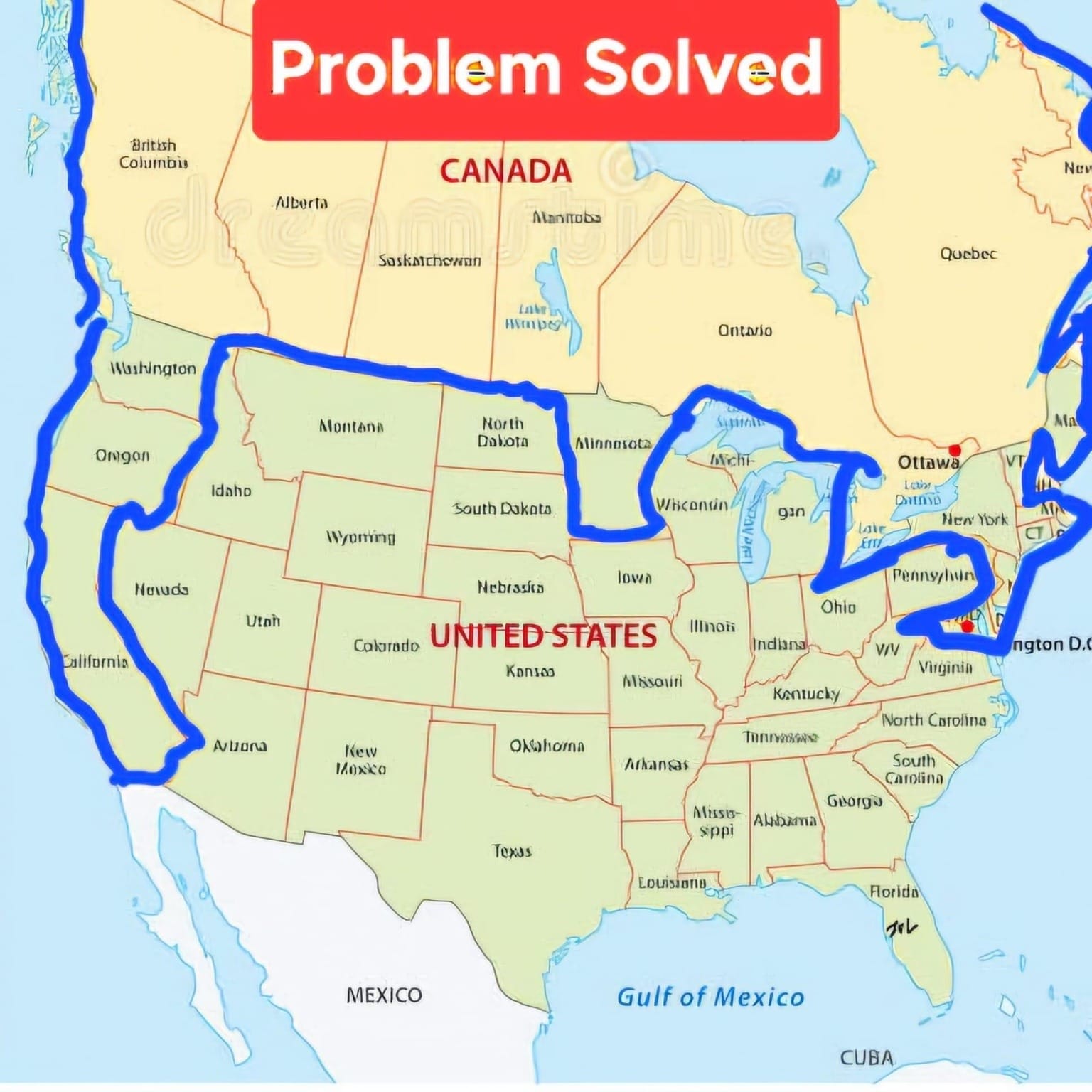
This viral meme depicts a hypothetical National Divorce U.S., dividing coastal and central regions, sparking discussions about secession and regional independence.
Forward: Mapping a Divided Nation
At Paranoid Prophet, we specialize in unraveling the bizarre, the hypothetical, and the unsettling—often with the precision of AI. When this viral meme depicting a National Divorce U.S. landed on our radar, we saw more than satire. It serves as a provocative visual encapsulation of growing public sentiment about dividing America. Could the United States truly split into coastal and central regions, as outlined in this map? And what would the political, economic, and cultural consequences of such a division look like?
Leveraging AI analysis, we delved into the implications of this “problem solved” map to explore its feasibility. In this article, we examine the fractures fueling this imagery—ranging from cultural polarization to economic interdependence—and evaluate whether this meme is a clever farce or a haunting forewarning of what might come.
As you dive deeper, consider this: satire often reflects uncomfortable truths. Is this map a whimsical fantasy, or does it expose the fragile state of the Union? Explore the realities of a National Divorce U.S. and decide how close—or far—we are from turning this meme into reality.
In today’s climate of deepening political and cultural polarization, the concept of a National Divorce U.S.—a hypothetical division splitting the nation into coastal and central regions—has shifted from fringe discourse to mainstream debate. The idea provokes profound questions: Can America reconcile its differences, or is it heading toward an inevitable fracture? Advocates for a National Divorce argue that regional autonomy would allow each bloc to govern according to its values and priorities. Critics, however, warn that such a split could dismantle a nation built on unity amid diversity, unleashing economic chaos and global instability.
The coastal states—known for progressive policies, tech-driven economies, and global connectivity—stand in stark contrast to the central regions, which prioritize resource-based industries, traditional values, and localized governance. Could these two Americas survive independently? Or would the unraveling of economic interdependence and shared identity create unprecedented challenges? This article explores the historical roots of these divisions, their modern implications, and whether a National Divorce U.S. is feasible—or disastrous.
The Historical Roots of Division
Early Republic: Foundations of Disunity
From its founding, the United States wrestled with sharp regional divides. The agrarian South, the industrializing North, and the expanding West each pursued distinct economic priorities and cultural norms. Coastal states quickly embraced global trade and urbanization, while central regions remained tied to agriculture and localized governance. These tensions, manifesting in early crises like the Missouri Compromise, laid the groundwork for regional rivalries.
Post-Civil War Divergence
After Reconstruction centralized federal authority, cultural and economic disparities persisted. Coastal regions became hubs of immigration, innovation, and urbanization, fostering progressive values. Meanwhile, central states clung to traditionalism and self-reliance. By the 20th century, terms like “flyover country” emerged, symbolizing growing coastal indifference to the heartland.
Modern Polarization
The late 20th century cemented the partisan divide. Coastal areas championed globalism, diversity, and progressive policies, while central states rallied around conservatism, religious traditions, and skepticism toward federal overreach. Landmark events—such as the 2000 election recount, the rise of the Tea Party, and debates over climate change—intensified these rifts. Today, the polarization is so entrenched that some call it a “cold civil war,” fueling calls for a National Divorce U.S. as a potential solution.
Economic Realities of a Divided Nation
Coastal Economies: Engines of Globalization
Coastal states dominate industries like technology, finance, and cultural exports. Key strengths include:
- Tech and Innovation: Silicon Valley drives the global tech economy with companies like Apple and Google.
- Finance and Trade: Wall Street anchors the global financial system.
- Cultural Influence: Hollywood and media industries give coastal states unmatched cultural soft power.
Despite these advantages, coastal economies are vulnerable to housing crises, income inequality, and reliance on volatile sectors. A National Divorce would require coastal states to secure essential resources—such as food and energy—produced by central states.
Central Economies: Resource Backbone
Central regions, often dubbed “America’s breadbasket,” are critical for food security and energy production:
- Agriculture: States like Kansas and Iowa supply much of the nation’s grain.
- Energy: Texas and North Dakota lead in oil and natural gas production.
- Manufacturing: Central states serve as hubs for logistics and industrial production.
However, central economies are highly dependent on federal subsidies and global trade, both of which could be disrupted by a National Divorce. Limited access to coastal ports and foreign markets would pose additional challenges.
Economic Interdependence
The coastal and central regions rely heavily on each other:
- Trade Routes: Central-state goods flow through coastal ports for global export.
- Energy Needs: Coastal states depend on fossil fuels from central regions.
- Labor Migration: Workers from central states seek higher-paying opportunities in coastal hubs, while seasonal labor supports agriculture.
Severing these ties would result in supply chain breakdowns, inflation, and economic hardship for both sides.
Cultural and Political Implications
Coastal Progressivism vs. Central Conservatism
Cultural differences between the coasts and the heartland fuel calls for a National Divorce:
- Coastal States: Progressive ideologies emphasize diversity, globalism, and renewable energy.
- Central States: Conservative values prioritize tradition, religious freedom, and resource independence.
These ideological divides are not just political but deeply cultural, shaping everything from education policies to environmental approaches.
Urban-Rural Tensions
Even within regions, internal divides would persist. Urban areas in central states often lean progressive, while rural areas in coastal states maintain conservative traditions. A National Divorce might replicate today’s conflicts on a smaller scale.
Can a National Divorce U.S. Work?
Legal and Constitutional Barriers
The U.S. Constitution presents formidable obstacles to secession:
- No Secession Clause: The Supreme Court ruled in Texas v. White (1869) that states cannot unilaterally secede.
- Federal Supremacy: Article VI establishes federal law as supreme, preventing states from overriding it without constitutional amendments.
Historical Lessons
The Civil War demonstrated the high costs of attempted secession, reinforcing the federal government’s authority. Modern secessionist movements like Texas’ “Texit” or California’s “Calexit” have gained attention but lack substantial public support.
Practical Challenges
Even if legally possible, a National Divorce would face immense logistical hurdles:
- Debt and Resources: Dividing national debt and federal assets would spark disputes.
- Commerce and Migration: New trade agreements and border controls would disrupt daily life.
- Defense: Splitting the U.S. military could leave both regions vulnerable to external threats.
Environmental Policies: A Tale of Two Americas
A National Divorce would highlight divergent environmental priorities:
- Coastal States: Leaders in renewable energy and international climate agreements, coastal regions prioritize green initiatives.
- Central States: Fossil fuel-dependent economies focus on balancing economic growth with environmental goals.
These opposing approaches could create energy imbalances, trade conflicts, and ecological challenges in both regions.
Public Sentiment and Secession Movements
Growing Support for Secession
Recent polls reveal growing interest in the idea of secession:
- Partisan Divide: Republicans, particularly in southern and central states, are more likely to support secession.
- Regional Variability: Support is highest in areas where residents feel culturally or economically alienated by federal policies.
Notable Movements
- Greater Idaho Movement: Rural Oregon counties seek to join Idaho, reflecting frustration with urban policies.
- Texit: Calls for Texas independence periodically resurface, often tied to dissatisfaction with federal mandates.
- Calexit: California’s economic clout fuels secessionist ambitions, but logistical barriers remain insurmountable.
Global Implications of a National Divorce
A fractured United States would have ripple effects worldwide:
- Weakened Influence: America’s global dominance would decline, empowering rivals like China and Russia.
- Defense Instability: Dividing the U.S. military could weaken global security.
- Inspiration for Other Movements: Secessionist groups in regions like Catalonia (Spain) and Quebec (Canada) might gain momentum.
Conclusion: The Fragile Union
The idea of a National Divorce U.S. underscores America’s deep divisions but also highlights the dangers of fragmentation. While regional autonomy may seem appealing to some, the economic, political, and social costs would be profound.
To avoid such a fate, America must address its underlying issues—economic inequality, cultural alienation, and political mistrust. The strength of the Union lies in its ability to unify diverse perspectives. Preserving that unity is essential to navigating the challenges of the modern era.
DARWIN’s Take
The call for a National Divorce U.S. isn’t a roadmap for the future—it’s an alarm bell. It echoes the discontent of a nation fatigued by cultural and political battles, a collective cry from a society on the brink of ideological burnout.
But here’s the unsettling question: Is unity even relevant in a world where individualism and hyperlocal priorities have taken center stage? What binds a nation when its languages, values, and economies diverge further with every election cycle, every Supreme Court ruling, and every social movement?
Perhaps the deeper crisis isn’t whether the Union can hold—it’s whether we still want it to.
If America fractures, geography won’t be the culprit. The real fault lines are intangible: mistrust, alienation, and the erosion of a shared purpose. These are forces that no border can mend and no wall can contain.
To avoid this fracture, the United States must confront its most uncomfortable truths. A democracy cannot function without compromise. A divided house cannot stand. And a nation unwilling to rediscover its shared identity may find itself choosing separation by default.
Sources
Paranoid Prophet Recommended Reading
Explore these related articles from our Politics category to dive deeper into the themes of national division and political dynamics in the U.S.:
- Trump’s Rally Record: How His Campaigns Stack Up Against Other U.S. Politicians’ Rallies
Discover how political rallies shape public opinion and contribute to national unity or division. - What to Expect: Trump’s Likely Moves from Election Win to Inauguration
Analyze the strategies and implications of political maneuvers during transitional periods. - Mail-In Ballots and Election Fraud: Risks, Safeguards, and 2024 Concerns
Examine electoral controversies and their role in fueling regional distrust and division. - Voter ID Laws and the Integrity of the 2024 Election: Access, Fraud, and the Cost of Disillusionment
External Sources
The following sources provide insight and credibility to the themes and arguments explored in this article:
Newsweek
- Article: California Secession Movement Wants National Divorce to Avoid ‘Civil War’
- Link: Newsweek: California Secession Movement
- Summary: This article discusses the “Yes California” secession movement, highlighting its call for a national divorce to prevent potential civil conflict.
Justia US Supreme Court Center
- Document: Texas v. White, 74 U.S. 700 (1868)
- Link: Justia: Texas v. White Decision
- Summary: This Supreme Court decision asserts that the United States is “an indestructible union” from which no state can secede, establishing a critical legal precedent.
Deseret News
- Article: What is a national divorce and why do people want one?
- Link: Deseret News: National Divorce Discussion
- Summary: This piece explores the concept of a national divorce, examining the reasons behind its growing discussion and the complexities involved.
The Week
- Article: National divorce: Could America be split in two?
- Link: The Week: National Divorce Debate
- Summary: This article delves into the feasibility and implications of a national divorce, considering legal, social, and economic perspectives.
American Thinker
- Article: On Secession: An Analysis of Texas v. White
- Link: American Thinker: Secession Analysis
- Summary: This analysis provides an in-depth look at the Supreme Court’s ruling in Texas v. White and its implications for modern secessionist movements.
Newsweek
- Article: Secession Movements Now in 12 US States, Campaigner Says
- Link: Newsweek: Secession Movements
- Summary: This report highlights the existence of secessionist movements across 12 U.S. states, reflecting the growing discourse on national division.
The Hill
- Article: Sometimes secession works: Why it won’t work for the US
- Link: The Hill: Secession Feasibility
- Summary: This opinion piece discusses instances where secession has succeeded elsewhere and analyzes why such a move would be problematic in the U.S. context.
Constituting America
- Article: Texas v. White (1869)
- Link: Constituting America: Texas v. White
- Summary: This article examines the Texas v. White case, providing insights into its historical context and lasting impact on the union’s indissolubility.
Reason.com
- Article: Debate: It’s Time for a National Divorce
- Link: Reason: National Divorce Debate
- Summary: This debate presents arguments for and against the idea of a national divorce, offering a balanced perspective on the issue.
Library of Congress
- Document: U.S. Reports: Texas v. White, 74 U.S. (7 Wall.) 700 (1869).
- Link: Library of Congress: Texas v. White
- Summary: This official record provides the full text of the Supreme Court’s decision in Texas v. White, a cornerstone in discussions about secession and union permanence.
FAQ: National Divorce U.S.
What is a National Divorce in the U.S.?
A National Divorce refers to the hypothetical division of the United States into separate regions, such as coastal and central states, based on political, cultural, and economic differences. The term symbolizes the growing polarization within the country and explores whether regional secession could address these divides.
Is a National Divorce U.S. legally possible?
Under current U.S. law, secession is unconstitutional. The Supreme Court’s ruling in Texas v. White (1869) declared that the Union is “perpetual” and cannot be dissolved unilaterally. Legal secession would require constitutional amendments or revolutionary action, both of which are highly improbable.
Which states or regions support the idea of secession?
Secessionist movements exist in several states, including:
- California (Calexit): Advocates for independence due to the state’s economic clout and progressive values.
- Texas (Texit): Driven by dissatisfaction with federal policies and a history of independence.
- Greater Idaho Movement: Rural Oregon counties seeking to join Idaho due to cultural and political differences.
What are the economic consequences of a National Divorce U.S.?
Economic impacts would be significant, including:
- Disrupted trade between regions.
- Divisions of federal assets, such as military bases and infrastructure.
- Challenges in allocating national debt and resources.
- Potential inflation and job losses due to supply chain disruptions.
How would a National Divorce U.S. impact national security?
Splitting the U.S. could weaken its global standing and defense capabilities by dividing the military, resources, and intelligence networks. Rivals like China or Russia might exploit a fractured America to expand their influence.
What are the cultural effects of a National Divorce U.S.?
A national divorce would deepen cultural divides:
- Coastal states might become more progressive, emphasizing multiculturalism and globalism.
- Central states could strengthen traditional values, focusing on localism and heritage.
- Shared American identities, such as national holidays and symbols, might erode, giving way to distinct regional cultures.
Have secession attempts occurred before in U.S. history?
Yes, the most notable attempt was the Confederate States’ secession during the Civil War (1861–1865), which ended in failure and reinforced federal authority. Modern movements, like Texas’s Texit or California’s Calexit, have gained attention but lack widespread support or legal pathways to succeed.
What do polls say about a National Divorce U.S.?
Polls show mixed opinions:
- A 2021 Bright Line Watch survey found that 37% of respondents in the South and 34% in the West support the idea of regional secession.
- Support is generally higher in areas where residents feel their values are not represented by federal policies.
What would happen to the U.S. Constitution in a National Divorce?
A national divorce would require significant constitutional changes, including amendments to allow secession. Alternatively, regions could attempt to draft their own constitutions, which would lead to legal and procedural chaos.
Could a National Divorce U.S. happen peacefully?
While peaceful separation is theoretically possible, it is highly unlikely due to the legal, economic, and cultural complexities involved. Any attempt at secession would likely spark intense conflict over resources, borders, and governance.
How can America avoid a National Divorce?
Avoiding a national divorce requires addressing the root causes of division:
- Promoting dialogue and compromise between polarized groups.
- Addressing economic disparities and cultural alienation.
- Strengthening federal systems while respecting regional autonomy.


